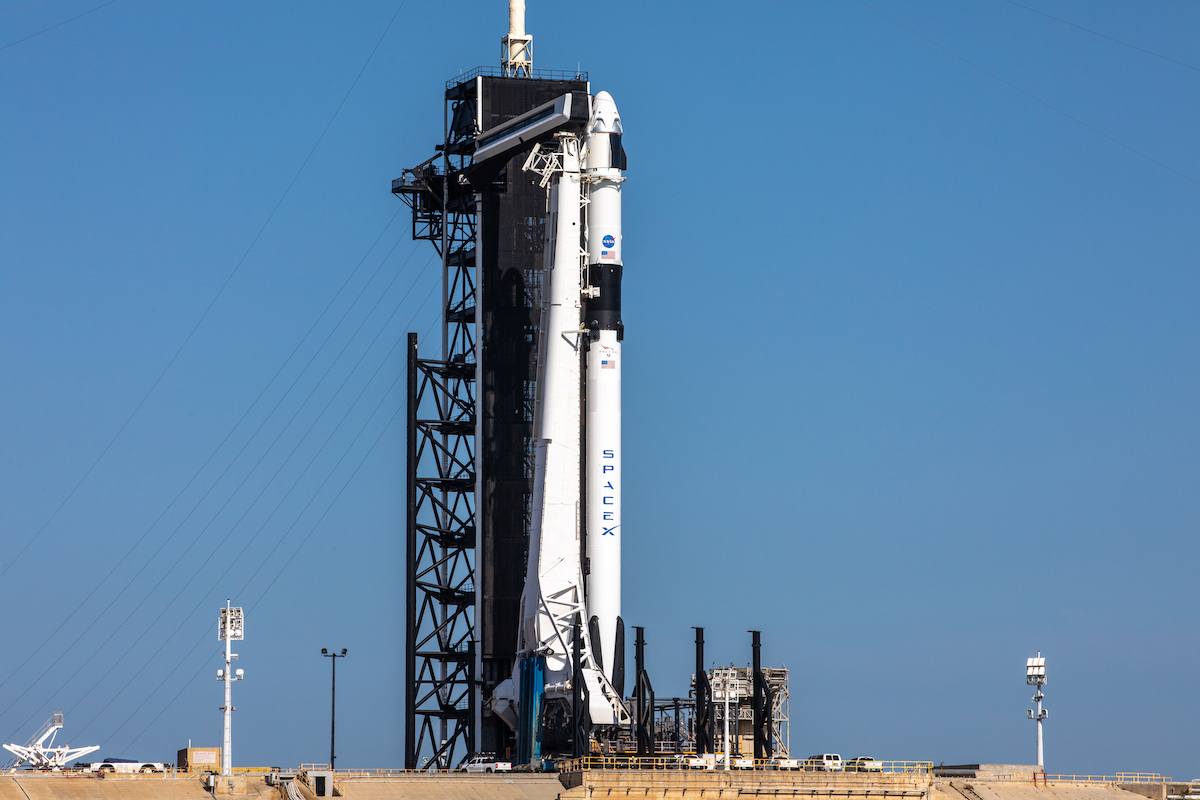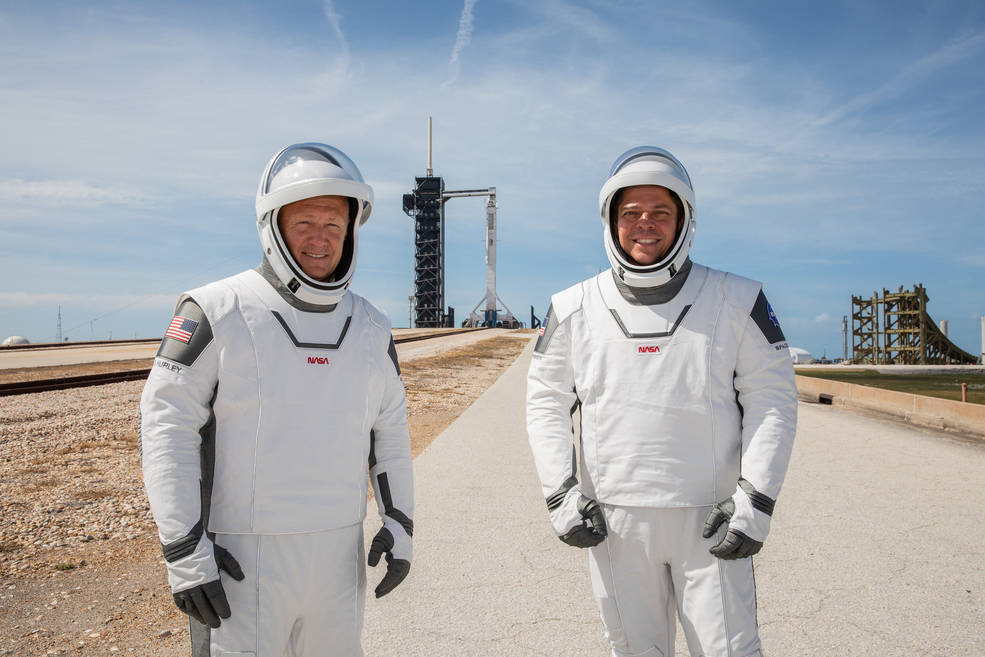
A SpaceX Falcon 9 rocket, with the Crew Dragon atop, stands poised for launch at historic Launch Complex 39A at NASA’s Kennedy Space Center in Florida on May 21, 2020, ahead of NASA’s SpaceX Demo-2 mission. The rocket and spacecraft will carry NASA astronauts Robert Behnken and Douglas Hurley to the International Space Station as part of the agency’s Commercial Crew Program, returning human spaceflight capability to the U.S. after nearly a decade. This will be SpaceX’s final flight test, paving the way for NASA to certify the crew transportation system for regular, crewed flights to the orbiting laboratory.

NASA astronauts Douglas Hurley (left) and Robert Behnken (right) participate in a dress rehearsal for launch at the agency’s Kennedy Space Center in Florida on May 23, 2020, ahead of NASA’s SpaceX Demo-2 mission to the International Space Station. Demo-2 will serve as an end-to-end flight test of SpaceX’s crew transportation system, providing valuable data toward NASA certifying the system for regular, crewed missions to the orbiting laboratory under the agency’s Commercial Crew Program. The launch is now scheduled for 3:22 p.m. EDT Saturday, May 30.
Credits: NASA/Kim Shiflett
A Unique Perspective
The historic launch today is being extensively covered by the media. With this post, I wanted to provide a unique SSEP perspective on this milestone for the U.S. space program.
The last time U.S. astronauts launched into space aboard a U.S. rocket was on July 8, 2011, with STS-135 – the final flight of Space Shuttle Atlantis, and the final flight of the U.S. Space Shuttle Program. STS-135 was commanded by astronaut Chris Ferguson, and piloted by Douglas Hurley. Today, nearly nine years later, Doug Hurley is piloting NASA’s SpaceX Demo-2 mission, along with astronaut Bob Behnken.
The flight of Atlantis was also a milestone for the Student Spaceflight Experiments Program. Atlantis carried the SSEP Intrepid payload of 11 experiments to the International Space Station, which was only the second SSEP payload to fly. The first SSEP payload flew aboard STS-134, the final flight of Space Shuttle Endeavour on May 16, 2011. The flights of Endeavour and Atlantis took place a year after SSEP was launched on June 7, 2010.
With the retirement of the Space Shuttles, SSEP made the historic transition to flying payloads aboard the new and unproven commercial vehicles designed to resupply the International Space Station – the SpaceX Falcon 9 rocket and Dragon spacecraft, and the Orbital Sciences Antares rocket and Cygnus spacecraft. To date, these vehicles have launched 14 SSEP payloads to ISS, with the next to launch – SSEP Mission 14 – in October 2020 aboard SpaceX-21. You’re invited to explore videos of every SSEP launch, and read about all the astronauts that have operated the SSEP experiments in space, over the last 10 years of SSEP program operations on the SSEP Launch and On-Orbit Operations History page.
The function of the Space Shuttles was transport of astronauts and cargo to Low Earth Orbit, construction of the International Space Station, and then Station resupply. Shuttles were not capable of going beyond Low Earth Orbit. The shuttle retirement allowed NASA to concentrate on building the Space Launch System (SLS) for deep space operations – a vehicle capable of taking astronauts back to the Moon, and to asteroids and Mars. The task of routine transport of astronauts and cargo to ISS would be contracted to commercial companies like SpaceX and Orbital Sciences (now Northrop Grumman Innovation Systems), which needed to step to the plate in a new and unprecedented way.
Dragon and Cygnus were robotic vehicles, unable to carry astronauts to space. In the intervening 9 years since Atlantis’ launch in 2011, U.S. astronauts could only get to ISS on the Russian Soyuz launched from Baikonur in Kazakhstan. The ultimate objective was for commercial companies to again re-establish America’s capacity to send U.S. astronauts to ISS on an American rocket, and after many years of effort, that moment arrives – today.
Below is the NASA press release on today’s launch at 3:22 pm EDT. Live mission coverage begins on NASA TV at 11 am EDT. Docking at ISS is scheduled for 10:29 am EDT Sunday May 31. The press release provides times of live coverage of the mission through Monday June 1. Also below is a NASA TV portal if you’d like to watch the launch right her on the SSEP website.
WATCH LIVE ON THIS NASA TV PORTAL
May 28, 2020
MEDIA ADVISORY M20-062
Updates to Coverage of Landmark NASA SpaceX Commercial Crew Test Flight
NASA will provide live coverage of prelaunch and launch activities for the agency’s SpaceX Demo-2 test flight, carrying NASA astronauts Robert Behnken and Douglas Hurley to the International Space Station.
NASA and SpaceX now are targeting 3:22 p.m. EDT Saturday, May 30, for the launch of the first commercially built and operated American rocket and spacecraft carrying astronauts to the space station. The first launch attempt, on May 27, was scrubbed due to unfavorable weather conditions.
Full mission coverage begins at 11 a.m., and will air live on NASA Television and the agency’s website, as well as numerous other platforms. The launch broadcast commentators are: Marie Lewis, Dan Huot, Gary Jordan, Derrol Nail, and Tahira Allen from NASA; and Lauren Lyons, John Insprucker, and Jessie Anderson from SpaceX; with special guest host and former NASA astronaut Leland Melvin. Postlaunch coverage commentators are Leah Cheshier, Courtney Beasley, Gary Jordan and Dan Huot from NASA; and Kate Tice, Siva Bharadvaj, and Michael Andrews from SpaceX.
Prelaunch coverage also includes a special performance of “The Star-Spangled Banner” by Grammy Award-winning singer Kelly Clarkson.
The SpaceX Crew Dragon spacecraft will launch on a SpaceX Falcon 9 rocket from historic Launch Complex 39A at NASA’s Kennedy Space Center in Florida, and is scheduled to dock to the space station at 10:29 a.m. Sunday, May 31.
This will be SpaceX’s final test flight for NASA’s Commercial Crew Program and will provide critical data on the performance of the Falcon 9 rocket, Crew Dragon spacecraft, and ground systems, as well as in-orbit, docking, and landing operations.
The test flight also will provide valuable data toward certification of SpaceX’s crew transportation system for regular flights carrying astronauts to and from the space station. SpaceX currently is readying the hardware for the first space station crew rotational mission, which would happen after data from this test flight is reviewed for certification.
Due to the coronavirus (COVID-19) pandemic, media participation in news conferences will be remote, with only a limited number of media, who already have been accredited, will be accommodated at Kennedy. For the protection of media and Kennedy employees, the Kennedy Press Site News Center facilities will remain closed to all media throughout these events.
To participate in the Kennedy briefing by phone, reporters must e-mail ksc-newsroom@mail.nasa.gov no later than one hour prior to each event.
To participate by phone in the post-arrival news conference held at NASA’s Johnson Space Center in Houston, reporters must contact the Johnson newsroom at 281-483-5111 no later than one hour prior to the event.
Live NASA coverage is as follows. All times are EDT:
Friday, May. 29
10 a.m. – Administrator Countdown Clock Briefing (weather permitting; limited in-person media only, no dial in)
NASA Administrator Jim Bridenstine
Kennedy Space Center Director Bob Cabana
NASA astronaut Kjell Lindgren
NASA astronaut Nicole Mann
Saturday, May 30
11 a.m. – NASA TV launch coverage begins (continues through docking)
3:22 p.m. – Liftoff
4:09 p.m. – Crew Dragon phase burn
4:55 p.m. – Far-field manual flight test
TBD p.m. – Astronaut downlink event from Crew Dragon
6:30 p.m. – Postlaunch news conference at Kennedy
Administrator Bridenstine
Kathy Lueders, manager, NASA Commercial Crew Program
SpaceX representative
Kirk Shireman, manager, International Space Station Program
NASA Chief Astronaut Pat Forrester
A media phone bridge will be available for this event. Mission operational coverage will continue on NASA TV’s Media Channel.
Sunday, May 31
TBD a.m. – Astronaut downlink event from Crew Dragon
10:29 a.m. – Docking
12:45 p.m. – Hatch Open
1:05 p.m. – Welcome ceremony
3:15 p.m. – Post-arrival news conference at Johnson
NASA Administrator Jim Bridenstine
Johnson Space Center Director Mark Geyer
NASA Chief Astronaut Pat Forrester
A media phone bridge will be available for this event. Launch commentary will switch to NASA TV’s Media Channel.
Monday, June 1
11:15 a.m. – Space Station crew news conference, with NASA astronauts Chris Cassidy, Bob Behnken, and Doug Hurley
12:55 p.m. – SpaceX employee event and Class of 2020 Mosaic presentation, with NASA astronauts Chris Cassidy, Bob Behnken, and Doug Hurley
The deadline for media to apply for accreditation for this launch has passed, but more information about media accreditation is available by emailing ksc-media-accreditat@mail.nasa.gov.
This test flight is a pivotal point in NASA’s Commercial Crew Program, which is working with the U.S. aerospace industry to launch astronauts on American rockets and spacecraft from American soil to the space station for the first time since 2011.
The goal of the Commercial Crew Program is to provide safe, reliable, and cost-effective transportation to and from the International Space Station. This could allow for additional research time and increase the opportunity for discovery aboard humanity’s testbed for exploration, including preparation for human exploration of the Moon and Mars.
For launch countdown coverage, NASA’s launch blog, and more information about the mission, visit:
https://www.nasa.gov/commercialcrew
The Student Spaceflight Experiments Program (SSEP) is a program of the National Center for Earth and Space Science Education (NCESSE) in the U.S., and the Arthur C. Clarke Institute for Space Education internationally. It is enabled through a strategic partnership with DreamUp PBC and Nanoracks LLC, working with NASA under a Space Act Agreement as part of the utilization of the International Space Station as a National Laboratory. SSEP is the first pre-college STEM education program that is both a U.S. national initiative and implemented as an on-orbit commercial space venture.
The Smithsonian National Air and Space Museum, the International Space Station U.S. National Laboratory, and Subaru of America, Inc., are U.S. National Partners on the Student Spaceflight Experiments Program. Magellan Aerospace is a Canadian National Partner on the Student Spaceflight Experiments Program.



